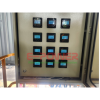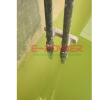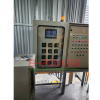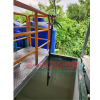Application of Industrial Information System (IIoT) in Waste Water Treatment Plant Management By num2002

Wastewater Treatment means improving the quality of wastewater to be better, making it less dangerous or less dangerous than before, using various processes such as physical processes, chemical processes, or biological processes.
Wastewater Treatment System
Wastewater treatment systems can be divided into 3 types:
1. Physical Treatment is a method of separating large waste or contaminants from wastewater using equipment in the physical treatment process, such as trash screens, grit traps, grease and oil traps, etc.
2. Chemical Treatment uses chemical processes to react with contaminants in wastewater, such as pH values that are too high or too low, toxic substances, suspended solids that are difficult to sediment, or excessive nitrogen or phosphorus. And there are germs, etc. Equipment used for chemical wastewater treatment includes fast-mixing tanks, slow-mixing tanks, sedimentation tanks, filters, and sterilization tanks.
3. Biological Treatment is a process that uses microorganisms to remove impurities in wastewater. The dirt or organic matter in the water will be used as food and an energy source for microorganisms in the microorganism tank for growth, resulting in less dirt in the wastewater. These microorganisms may be aerobic (Aerobic Organisms) or anaerobic (Anaerobic Organisms). Wastewater treatment systems that use biological principles include activated sludge (AS), oxidation ditch (OD), sequencing batch reactor (SBR), aerated lagoon (AL), rotating biological contactor (RBC), trickling filter, and stabilization tank. (Stabilization Ponds), Upflow Anaerobic Sludge Blanket (UASB) and Anaerobic Filter (AF) systems, etc. ...
Nowadays, the problem of water quality is one of the major issues that need to be solved sustainably. Global economies and societies are greatly affected by chemicals and pollutants in water, which have long-term effects on human health and the environment. Therefore, Haiwell Cloud Gateway (Internet of Things) technology has become an important tool in developing existing water chemical destructive systems, focusing on improving water quality efficiently and sustainably. In this article, we will explore the application of IoT technology in water chemical destructive systems and the effectiveness of using this technology to create clean water of the future.
Improving the chemical destruction system in water with IoT technology
Using IoT technology to improve the chemical destruction system in water has many benefits, both in terms of the safety of the water consumed and the improvement of the environment. It can create the following benefits:
1. Automatic measurement and control: IoT sensors can continuously measure the level of chemicals in water and send data to the computer system for analysis and reporting. The computer system can automatically improve the chemical destruction process based on the data received to make the destruction more efficient and the water quality more efficient.
2. Reduce unnecessary chemical use: By automatically measuring and controlling through the IoT system, the amount and rate of chemical use can be adjusted as appropriate, reducing the amount of unnecessary chemical use, which results in environmental friendliness and saving resources.
3. Effective reporting and control: IoT information and reporting systems enable timely reporting of data and system operation, and can accurately implement improvements according to the needs of the community at the right time.
IIoT System Operation in Water Chemical Destruction, Haiwell Free SCADA Cloud System
We can summarize the operation of IoT system in water chemical destruction as follows:
Improving the water chemical destruction system using IoT technology is a potential method to reduce chemical emissions and pollution in water. IoT technology can help make chemical destruction more efficient by controlling and improving the process of chemical destruction used in water. IoT devices can be installed on the chemical destruction system to measure and control the amount of chemicals used in the destruction, and adjust the concentration and usage rate as appropriate.
Example of IoT-Haiwell Could SCADA + PLC/PAC application in chemical destruction system
| Usage | Details | Example |
| Water quality measurement | Sensors for pH, conductivity, chlorine, heavy metals, etc. | pH sensor in wastewater treatment system |
Water treatment system control | Smart valves, smart water pumps, automatic control systems | Smart valve controls water flow in RO water treatment system |
| Notification | SMS, email, and application notifications | Alarm system when chemical level in water exceeds standard value |
Advantages of Using IoT in Chemical Destruction Systems
| Advantages | Details | Example |
| Efficiency | - Increase water treatment efficiency - Detect and remove chemicals faster - Reduce water treatment time | - Automatic control system adjusts the flow of chemicals according to the sensor value - Alert system when the chemical value exceeds the specified value |
| Accuracy | - Precise control of water treatment system - Adjust chemical dosage appropriately - Reduce environmental risks | - Sensor measures the chemical concentration in real time - Automatic control system adjusts the chemical mixing ratio |
| Economy | - Save energy - Save resources - Reduce water treatment costs | - Intelligent water pump adjusts the speed according to the sensor value - Automatic control system reduces the use of chemicals |
Safety | - Alert users when chemicals leak - Reduce health risks - Increase work safety | - Alert system via SMS, email, application - Automatic chemical flow blocking system |
IoT devices in chemical destruction systems
| Equipment | Details | Working example |
| pH Sensor | - Measures water acidity-alkalinity - Measuring range 0-14, displays real-time pH | - Control the acid or alkaline system - Alert when the pH value exceeds the standard value |
| EC/TDS Conductivity Sensor | - Measures water's ability to conduct electricity - Displays real-time conductivity | - Check the efficiency of the ion exchange system - Alert when the conductivity value exceeds the standard value |
| Chlorine Sensor | - Measures chlorine level in water - Displays real-time chlorine value | - Control the chlorine system - Alert when the chlorine value is too low or too high |
| Temperature Sensor | - Measures water temperature - Displays real-time temperature value | - Control the heating/cooling system - Alert when the temperature exceeds the standard value |
| Turbidity Sensor | - Measures the amount of particles suspended in water - Displays real-time turbidity value | - Check the efficiency of the filter system - Alert when the turbidity value exceeds the standard value |
| Dissolved Oxygen Sensor | - Measures dissolved oxygen in water - Displays real-time oxygen value | - Control the aeration system - Alert when the oxygen value is too low |
| Electric Valve | - Controls water flow - Remote control - Set on/off time | - Control the flow of chemicals - Adjust the water flow rate according to the sensor value |
| Smart Pump | - Controls water pumping speed - Remote control - Set working time | - Adjust the water pumping rate according to the sensor value - Save energy |
| Automatic PLC/PAC Control System | - Automatically controls water treatment system - Analyzes data from sensors - Adjusts system operation according to sensor values | - Control the pH, chlorine, temperature, etc. - Alert the user when there is a pollution problem |
Since PLC (Programmable Logic Controller) systems are widely used in the industry today, Haiwell's PLC system stands out for its ease of programming and using. It can connect to various sensors in the wastewater treatment system such as DO, PH/TDS, Chlorine, Turbidity, Flow and Level sensors easily and without complications. It communicates via Modbus RS485, 4-20 mA, 0-10V. It can choose to connect an additional Expansion card. In addition, if the system has a problem or exceeds the specified value, it can send a Line Notification alert. It can also remotely fix the system or program. Furthermore, the control and storage of Data logger values can retrieve various data to create a Report via the Haiwell Cloud system, saving time from having to record values and obtaining accurate values to create environmental reports. E-Power Service Co., Ltd. offers free service with no additional costs throughout the usage.

Ref :
www.pcd.go.th/faqs/คุณภาพน้ำและมลพิษทางน้ำ
https://env.anamai.moph.go.th/web-upload/migrated/files/env/n920_0d91709ae44cc4c5eef930979663d006_a036.pdf
http://www3.rdi.ku.ac.th/cl/knowledge/2566/dec/water_qualitytest.pdf






